In our company’s white papers and Leisure eNewsletters, we’ve been documenting the long-term trend of almost all the growth of our entertainment and socialization time and spending going to on-screen and at-home digital options rather than to out-of-home (OOH) experiences. From just before the Great Recession of 2008 until 2018, our average digital leisure time grew by 21 minutes a day while average OOH entertainment and arts (E&A) time only grew by about 0.3 minute a day. In 2006/2007, the average age 15+ person’s digital leisure time was 26 times as much as their OOH E&A time. In just a little over a decade in 2017/2018 it had grown to 28 times as much.
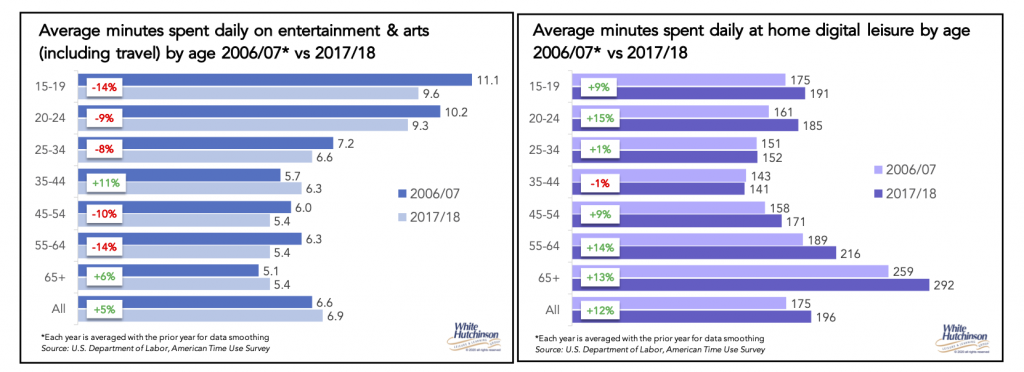
The growth for spending was similar. Average inflation-adjusted household spending for digital entertainment equipment and services grew by $289 while spending for OOH E&A grew by only $9. In 2018, the average household spent 10 times as much on digital entertainment as on E&A fees and admissions.
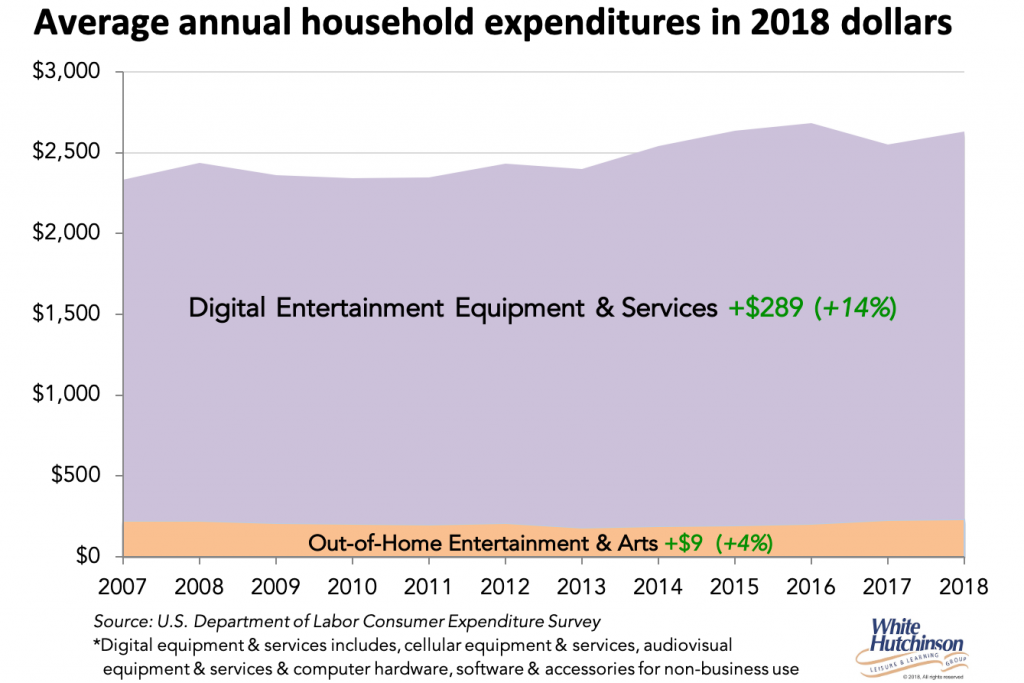
Then along comes the coronavirus ending our in real life (IRL) OOH existence and eliminating all our away-from-home entertainment time and spending, leaving us with only at-home digital alternatives for our socialization and entertainment. And even after the lockdowns end and location-based entertainment venues (LBEs) reopen, as my previous blog showed, the vast majority of people still do not plan to attend, leaving them continuing to use their at-home digital options.
The pandemic has accelerated the migration of entertainment and socialization from the real to the digital world. We’re seeing:
- The development of many new and improved at-home entertainment and social digital virtual experiences
- Their adoption by many people who have never used them, the “virtual immigrants,” and
- Their increased use by the already digital and virtual natives.
One big area of growth has been with video chat. During the lockdown and at-home isolation, video chat has become the closest substitute we have for in-person socialization. As humans, we evolved to communicate not only through words and voice intonation, but also by facial expressions and body language. Video provides much higher fidelity social communication than occurs with synchronous voice and is far superior to asynchronous text. Video chat also offers group socialization.
There are now many video chat options including Zoom, Messenger Rooms by Facebook, Houseparty and Google Hangouts. Their use as a virtual social meeting space has skyrocketed. In the very early stages of the stay-in-place orders in early April, the Pew Research Center found that one-third of U.S. adults (32%) had already attended a virtual party or social gathering with friends or family. An April 24-23 Ipsos/Mozilla poll found that 57% of Americans are currently using video chat platforms, with 38% saying they are using them for the first time since the pandemic.

Social simulation games, a species of video game where you control the life of a character inside a simulated world, are booming. Spending time on your private island in Nintendo’s Animal Crossing: New Horizons has become the perfect pandemic entertainment experience where you can escape into a perfect world of your own making and control. There you can terraform and customize your very own fantasy island and can also hangout and chat with your friends. It’s attracting lots of people who’ve never played video games before.
The Getty Museum created an Animal Crossing Art Generator that allows players to collect famous pieces of artwork from the museum’s archive and bring the artworks into their virtual homes in New Horizons. A for-profit commercial company, Olivia’s, a housewares brand, has introduced interior design services for virtual homes in the New Horizons game. They are recruiting design consultants who will work remotely and earn $49 an hour for their services. New Horizons has become an alternative wedding destination, fashion designers are launching clothes in it, AOC has even visited with a few fans. There’s even a late-night talk show that takes place in Animal Crossing.
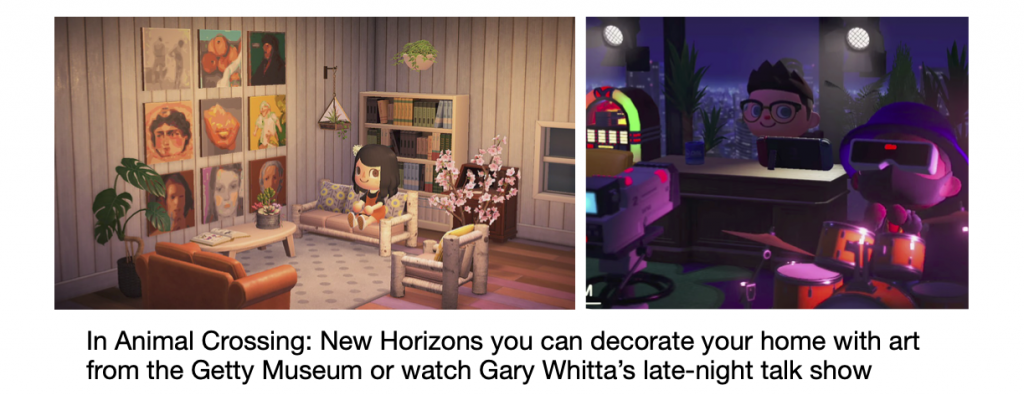
Animal Crossing is not the only game to create a virtual leisure escape for people. Stardew Valley is a similar land development game. Other popular ones include My Time at Portia, The Sims 4, Minecraft and Rune Factory 4.
The popular video game Fortnight is now hosting concerts and talk shows, transforming itself from just a video game into a social platform. In many respects, the game aspect itself has become secondary to a place where people can connect and spend time together.
Students at some universities are roaming the halls in their rebuilt closed college campuses they created virtually in Minecraft.
New virtual spaces are recreating the thrill of a night out. BrewDog Bar is replicating its traditional bar experience by creating 102 different virtual meetup bars to give customers the chance to get together with their regulars to enjoy a beer. Club Quarantine is a virtual gay club that hosts DJ sets with world-famous artists. Club Matryoshka is a Manila-based exclusive club located in Minecraft in a bespoke crafted virtual space with sound stages, DJ booths, dance floors and views of unique skylines and landscapes. People are even paying money to attend virtual venues like Club Quarantee, an online nightclub on Zoom. In all these virtual spaces, players can enjoy the entertainment and interact with other attendees as if they were at an IRL event.
The coronavirus has been the catalyst for the creation of a variety of digital alternatives for IRL events of all types taking place in virtual shared spaces including happy hours, crafting parties, concerts, nightclubs, listening parties, weddings, graduations, playdates, birthday parties, and memorial services. Heck, we even now have virtual princess pajama parties for 4-year-olds.
Many of these virtual experiences fall into a trend called “fantasy IRL,” the phenomenon of imagined worlds (virtual, in-game or fictional worlds) colliding with the real world. The virtual space becomes, for its inhabitants, almost as real as the real world, something like the metaverse. During the Covid-19 lockdown, the real world became the virtual world. Our face-to-face interactions became virtual. Our social “third places” were only found in the virtual world.
Virtual alternatives to IRL experiences have many advantages. No need to get dressed – attend in your PJs. No need to spend time traveling to the event. No lines to the restroom at virtual concerts. Watch movies with Netflix Party while simultaneously chatting with your friends, something you can’t do in the movie theater.
The exponential digital technology evolution that took place over the last few months is rewiring the way we do things. When Covid-19 caused peoples’ 2019 P.C. (Pre-Coronavirus) IRL normals to disappear and there was so much uncertainty, they sought a sense of routine and comfort by turning to the new digital virtual entertainment and social options available to them in their homes. People’s virtual experiences became their new normals.
I see the migration to all these new virtual worlds reshaping long-term how we will connect and be entertained post-lockdown and even when the pandemic and all its restrictions on our IRL experiences have passed. The new at-home virtual options pass the two tests for a habit to continue – first it needs to bring some benefits, and second the constraints of keeping up with the habit need to be low, it is easy to continue.
We will not be going back to our 2019 P.C. out-of-home social and entertainment normal. Many people will continue to embrace the virtual social and entertainment behaviors and routines they developed during the pandemic, replacing some of the time they spent pre-Covid-19 away from home for entertainment and socialization. The previously mentioned Ipsos/Mozilla poll found that 75% of Americans say they will continue to use video chat after lockdown measures are lifted to see friends and/or family and 9% say they will continue to use them for dating.
Our new virtual worlds, opportunities and habits will be new formidable competition to the forms of LBEs that existed 2019 P.C. The virtual experiences raise the bar for what it takes to get lots of people to again leave their homes to visit OOH entertainment.
One way to understand this behavior shift is the trade-off people make for their entertainment experiences. It’s a trade-off between the Fidelity, the quality of an LBE experience (which is predominately driven as much by the social component) and the Convenience of their at-home digital virtual social and entertainment options, measured and evaluated based in investment of effort, time and money.
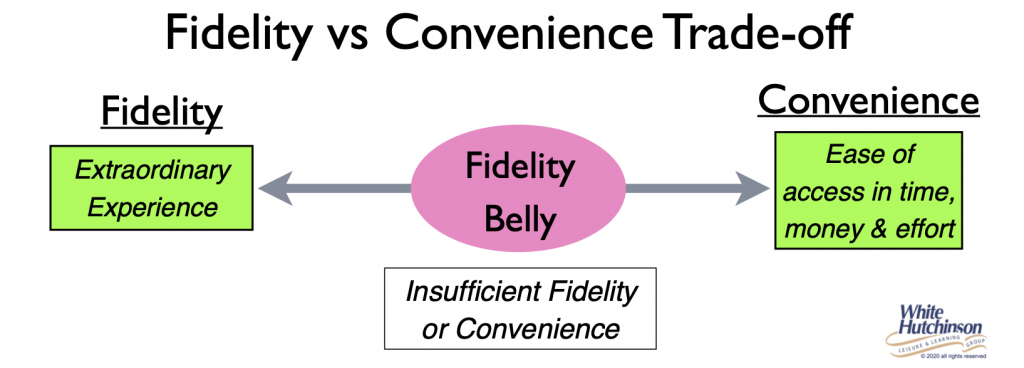
The more Convenient digital at-home entertainment and socialization becomes, the higher the Fidelityof an OOH entertainment experience has to become to compete and attract people. And as digital entertainment and socialization improves in Convenience as it has during the pandemic and is sure to continue to, what used to be a High Fidelity experience is no longer considered High Fidelity and falls into what is called the Fidelity Belly, not a place any venue wants to find itself as it has no appeal.
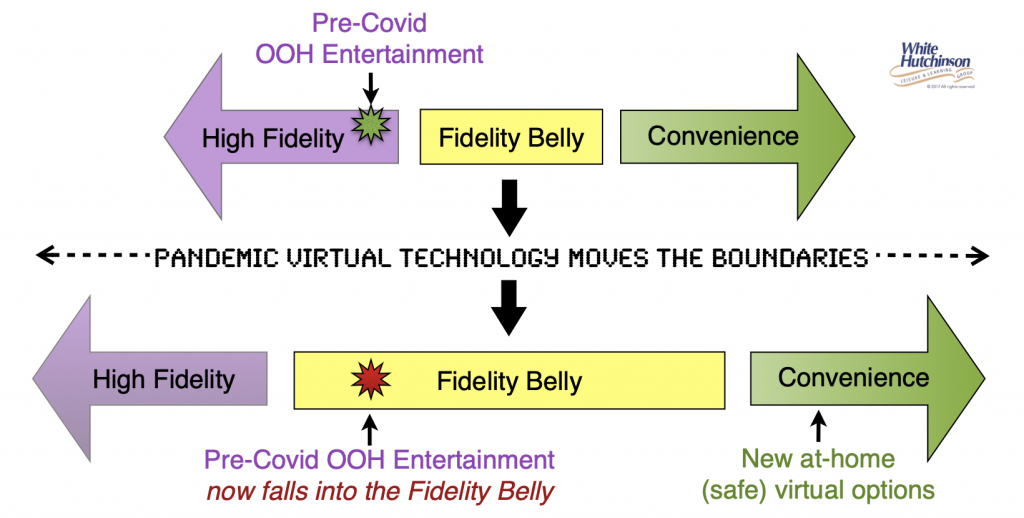
To win, you need to be at one end of the axis or another, and ten times better than what you’re aiming to replace. Which means ten times more high-impact and or high-quality or ten times cheaper, less time consuming and easier to do.
Rock-concerts are not convenient (they take time, effort and money to attend), but they offer a High Fidelity experience. MP3’s music on a smartphone is compressed and removes much of a sound quality, offering a low-fi experience, but is very Convenient. Attending a virtual concert within Fortnite now offers a better experience than just listening to music on a smartphone and is more appealing than previous at-home options.
The coronavirus has introduced a whole new measure to the Fidelity-Convenience Trade-Off. It’s the cost-benefit analysis of safety. Convenient at-home virtual experiences not only require little effort and time, but they are also safe from the coronavirus. With OOH entertainment and socialization experiences, there is a risk of catching Covid-19. And some of the highest Fidelity LBE experiences, such as a large music concert, have the highest risk.
For a large portion of the population afraid of either catching coronavirus or bringing it to their loved ones, there is no level of OOH Fidelity that will get them away from their safe at-home options. Depending on the type of OOH experience, surveys we have been analyzing show that percentage can be as high as one-third, at least until there is a vaccine for Covid-19. And even after that, there is a small percentage of people who have become extremely germophobic and may never return.
There is one other pandemic change that is affecting the Fidelity-Convenience Trade-Off for LBEs. Until there is a vaccine, the Fidelity of all 2019 P.C. LBE experiences has actually decreased due to social distancing, mask wearing and other Covid-19 related restrictions. This includes the restaurant and bar aspects of a visit. Businesses can no longer offer the level of service practices and hospitality as in the past. Socialization, the primary reason most people visit entertainment venues, is not the same when you can’t see a person’s whole face and their smiles. Always worrying about social distancing takes effort. It’s stressful to be concerned about everything you touch. Half-full venues are not as exciting. Visiting an LBE will be not as enjoyable an experience as it was in 2019 P.C.
So besides needing to implement all the safety features and practices that LBEs require during corona-time, in order to stay competitive and to offset the diminished appeal those measures create for a visit and the increased Convenience of the new and widely adopted at-home virtual entertainment and socialization options, LBE experiences need to improve, they need to become Super-Fidelity. Their previous status quo is no longer enough to succeed, as they will fall into the Fidelity Belly.
LBEs that are reopening need to understand that they are now a startup in a new reality with new restrictions placed on how they can operate their businesses and that they are now operating in a completely different competitive landscape with a completely transformed customer base. This will require an evolved and improved business model to make it through to the other side of the pandemic and beyond.
Make no mistake. One thing is certain. By the time we get to the post-pandemic world, the LBE industry and its landscape will be different.



